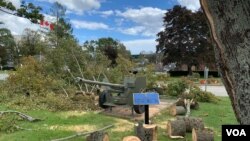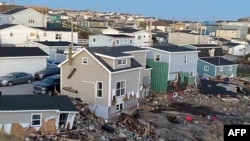Hurricane Fiona was already a deadly storm when it reached Atlantic Canada late on September 23, having taken several lives in the Caribbean. Now the death toll from Fiona in Atlantic Canada is three and counting.
Canada’s CBC News reported that the total insurance bill for Fiona in Atlantic Canada could top $500 million (Cdn 700 million), and that much of the damage is not covered by insurance policies, which do not provide for storm surges.
A week later, the cleanup for what was described as the strongest storm to ever hit Canada drags on. Countless houses are still without power, and debris remains scattered across the city in Halifax, Nova Scotia's capital.
Help your neighbors
“My message would be to the people who have done OK, which is to help the ones who haven’t,” Halifax Mayor Mike Savage told VOA. “This was a strong storm and the unfortunate thing is we’re going to get more of them and we’re going to have to be as ready as we possibly can for them.
“We’re in pretty good shape overall. We’ve moved hundreds of trees off public property. We didn’t have houses that were washed away like other communities.”
Debris from fallen trees is a common sight across the city, the biggest in Atlantic Canada and a regional hub for government and commerce.
Savage said he learned a great deal by watching from Halifax’s Emergency Operations Center as the storm passed through, including the importance of response personnel taking notes that can be checked on later.
“At the Emergency Operations Center, don’t throw anything away. Every note that you make, see what kind of things were happening in real time, see if we can improve it,” he said.
This reporter personally lost all of his belongings when water started pouring into his basement apartment after the batteries on the sump pumps ran out during a weeklong power outage. He was told on Wednesday that he had an hour to rescue any items of sentimental value from his apartment before it was left to flood for an indefinite period.
Much of the province was blindsided by the widespread power outages that kicked in as the storm’s outer edges reached Nova Scotia, prompting a rash of fearful postings on Twitter. For most, the sense of foreboding was more severe than during Hurricane Dorian, that last major storm to rattle Atlantic Canada in 2019.
'Incredible' storm
“I have never seen anything like it before,” said Scott Ellis, who works in the nonprofit industry and ran for office in the 2021 provincial election for the Progressive Conservative Party of Nova Scotia. “The wind and storm surge that occurred were incredible. They told us it could be historic, but with these things you always hope they’re wrong.
“Our region does not have the infrastructure built for these types of storms and obviously the destruction is quite evident. While the damage is widespread and saddening, Atlantic Canadians are coming together to support their communities in the recovery.”
Hadrian Mertins-Kirkwood, an expert at the Canadian Center for Policy Alternatives, said scientists have been warning for decades that climate change would lead to more frequent and more extreme weather events.
“The awful destruction left by Fiona points to a big oversight in Canadian climate policy, which is adaptation to the effects of climate change,” he said in an interview.
“Even if we were to cut our greenhouse gas emissions to zero overnight, we're still going to suffer the effects of all our previous accumulated emissions. A certain amount of global warming is already locked in. So we need to be preparing our infrastructure for more storms like this in the future, even as we make every effort to reduce our greenhouse emissions in the present,” Mertins-Kirkwood said.








